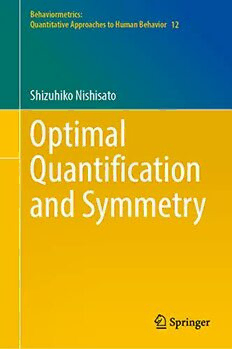Table Of ContentBehaviormetrics:
Quantitative Approaches to Human Behavior 12
Shizuhiko Nishisato
Optimal
Quantification
and Symmetry
Behaviormetrics: Quantitative Approaches
to Human Behavior
Volume 12
SeriesEditor
AkinoriOkada,ProfessorEmeritus,RikkyoUniversity,
Tokyo,Japan
This series covers in their entirety the elements of behaviormetrics, a term that
encompasses all quantitative approaches of research to disclose and understand
human behavior in the broadest sense. The term includes the concept, theory,
model, algorithm, method, and application of quantitative approaches from
theoretical or conceptual studies to empirical or practical application studies to
comprehend human behavior. The Behaviormetrics series deals with a wide range
oftopicsofdataanalysisandofdevelopingnewmodels,algorithms,andmethods
toanalyzethesedata.
Thecharacteristicsfeaturedintheserieshavefouraspects.Thefirstisthevariety
ofthemethodsutilizedindataanalysisandanewlydevelopedmethodthatincludes
not only standard or general statistical methods or psychometric methods
traditionally used in data analysis, but also includes cluster analysis, multidimen-
sional scaling, machine learning, corresponding analysis, biplot, network analysis
and graph theory, conjoint measurement, biclustering, visualization, and data and
web mining. The second aspect is the variety of types of data including ranking,
categorical, preference, functional, angle, contextual, nominal, multi-mode
multi-way, contextual, continuous, discrete, high-dimensional, and sparse data.
The third comprises the varied procedures by which the data are collected: by
survey, experiment, sensor devices, and purchase records, and other means. The
fourthaspectoftheBehaviormetricsseriesisthediversityoffieldsfromwhichthe
data are derived, including marketing and consumer behavior, sociology, psychol-
ogy, education, archaeology, medicine, economics, political and policy science,
cognitive science, public administration, pharmacy, engineering, urban planning,
agricultureandforestryscience,andbrainscience.
Inessence,thepurposeofthisseriesistodescribethenewhorizonsopeningup
inbehaviormetrics—approachestounderstandinganddisclosinghumanbehaviors
both in the analyses of diverse data by a wide range of methods and in the
developmentofnewmethodstoanalyzethesedata.
EditorinChief
AkinoriOkada(RikkyoUniversity)
ManagingEditors
DanielBaier(UniversityofBayreuth)
GiuseppeBove(RomaTreUniversity)
TakahiroHoshino(KeioUniversity)
Moreinformationaboutthisseriesathttps://link.springer.com/bookseries/16001
Shizuhiko Nishisato
Optimal Quantification
and Symmetry
ShizuhikoNishisato
UniversityofToronto
Toronto,ON,Canada
ISSN2524-4027 ISSN2524-4035 (electronic)
Behaviormetrics:QuantitativeApproachestoHumanBehavior
ISBN978-981-16-9169-0 ISBN978-981-16-9170-6 (eBook)
https://doi.org/10.1007/978-981-16-9170-6
©TheEditor(s)(ifapplicable)andTheAuthor(s),underexclusivelicensetoSpringerNature
SingaporePteLtd.2022
Thisworkissubjecttocopyright.AllrightsaresolelyandexclusivelylicensedbythePublisher,whether
thewholeorpartofthematerialisconcerned,specificallytherightsoftranslation,reprinting,reuse
ofillustrations,recitation,broadcasting,reproductiononmicrofilmsorinanyotherphysicalway,and
transmissionorinformationstorageandretrieval,electronicadaptation,computersoftware,orbysimilar
ordissimilarmethodologynowknownorhereafterdeveloped.
Theuseofgeneraldescriptivenames,registerednames,trademarks,servicemarks,etc.inthispublication
doesnotimply,evenintheabsenceofaspecificstatement,thatsuchnamesareexemptfromtherelevant
protectivelawsandregulationsandthereforefreeforgeneraluse.
Thepublisher,theauthorsandtheeditorsaresafetoassumethattheadviceandinformationinthisbook
arebelievedtobetrueandaccurateatthedateofpublication.Neitherthepublishernortheauthorsor
theeditorsgiveawarranty,expressedorimplied,withrespecttothematerialcontainedhereinorforany
errorsoromissionsthatmayhavebeenmade.Thepublisherremainsneutralwithregardtojurisdictional
claimsinpublishedmapsandinstitutionalaffiliations.
ThisSpringerimprintispublishedbytheregisteredcompanySpringerNatureSingaporePteLtd.
The registered company address is: 152 Beach Road, #21-01/04 Gateway East, Singapore 189721,
Singapore
Dedicatedto:
MywifeLorraine,sonIra,Samantha Dugas
grandsonLincolnDugas-Nishisato in
Canada
and
MysisterMichikoSomaandbrotherAkihiko
NishisatoinJapan
fortheirmanyyearsofconstantandtotal
support
inmypersonalandprofessionallife!
Preface
Themajorroleofquantificationtheoryistotransformqualitativedataintoquanti-
tativedatasothatourfamiliararithmeticoperationscanbeusedtoanalyzethedata.
Thedesideratumofthistransformationistointroducesomeoptimalcharacteristics
intothetransformssothatwemayhopefullygraspcomplexinformationcontained
intheoriginaldatainthemosteffectiveway.
Quantification theory has existed for roughly 100 years and many researchers
havebeeninvolvedinitsdevelopment.Duringtheseyears,alargenumberofbooks
andresearchpapershavebeenpublishedonthetopic.Therefore,somereadersmay
wonderwhythisbooknow?
Themainreasonistopresentanewperspectiveofquantificationtheoryinterms
of“symmetry”whichappearsthroughoutitsmathematicsandgeometry,andmost
importantlyinthecontextofsymmetrycombinedwithoptimization.
“Symmetry”appearsinmathematics,biology,artsandoureverydaylife,alloccu-
pyingsomestatusofdesirable,fineandsupremecharacters.Indeed,symmetryisalso
aparamount,underlyingprincipleforquantificationtheory.Thisnewlookwillhelp
dissolvesomeicesurroundingthetheoryandhopefullybringitsattractivenesscloser
tothereaders.Besurethatsymmetryandoptimizationwillindeedplaytheroleof
anironcladframeworkformultidimensionalquantification.
Inthecurrentbook,wewillstartwiththereasonwhyoptimalquantificationshould
bepursued,usingexamples.Then,wediscussinputdataforquantificationandthe
objectivesofquantification.Thisistomakesurewhatkindsofdataareappropriate
forquantificationandwhatisthegoalofquantification.Wewillthenproceedfrom
simplestepsforquantificationtohandlingcomplexproblemsstepbystep.
Thisbookisgearedfortypicaluniversitycoursesondataanalysis.Withenough
mathematicsandnumericalexamples,thecurrentbookwillattracttheattentionof
notonlyeagerstudents,butalsomanyseasonedresearchers.
RecentlyIreadabookwrittenbymyuniversityclassmate,Mr.HideshiSeki,a
noted historian in Japan, who published a book on the pioneer days of Hokkaido,
Japan,basedonhisseriesoflectures.Throughacleaverarrangementofthequestions
from his students, the entire book became an excellent introduction to the history.
IwassoimpressedwiththestyleofMr.Seki’sbookwhichevenanoutsidercould
vii
viii Preface
easily grasp and appreciate the history. His book motivated me to write this book,
immediatelyafterfinishinga2021Springerbookwiththreeotherfriends,mentioned
inthenextparagraph.
During the past few years, I felt uneasy about one topic of quantification, joint
graphical display. Thus, this topic became the central issue of my contribution
to Nishisato, Beh, Lombardo and Clavel (2021). When the book was completed,
however,Mr.Seki’sbookmademewonderifIhadexplainedquantificationtheory
clearenoughtothereaders.Thispromptedmetowritethecurrentbook.Toworry
about a little thing like this may be a sign of senior moments, but I still hope that
somereaderswillfindthecurrentbookinteresting,usefulandappealingenoughto
read.
ThebookisnotasequeltoNishisato,Beh,LombardoandClavel’s ModernQuan-
tification Theory: Joint Graphical Display and Alternatives, Singapore: Springer
Nature (2021). As compared with this book, the current book is introductory, but
theobjectistoelucidatefurtheraverybasicsymmetricframeworkflourishedinthe
earlydaysofquantificationtheory.Assuch,Ihopethebookwillservewellasagood
companionbooktothebookbyNishisato,Beh,LombardoandClavel.Thetopics
werearrangedsothattheentirespectrumofquantification theoryiscovered inan
understandableway.Maythebookserveasavaluableadditiontothequantification
theoryliterature.
Finally,Ihavetoapologizetothereadersabouttwopersonalmatters.First,since
my1960paperonfactoranalysis,timehaspassedratherquickly.Towriteabook
based on my chosen career, it is natural to cite my own work perhaps too often.
ShouldIappearterriblyconceitedorifyoufeelslightedbymynotreferringtoyour
workequallyextensively,pleasedoacceptmysincereapologies.Second,Itookthe
libertyofacknowledging thefriendship ofmany friends,including those frommy
childhood. This maybe unusual, butplease excuse meforthatsinceitwas due to
myselfishandsentimentalurgetodoso.
Toronto,Canada ShizuhikoNishisato
November2021 ProfessorEmeritus
Acknowledgments
TheauthorwishestoacknowledgethegeneroussupportofDr.AkinoriOkada,the
EditorofSpringerBehaviormetricsSeries,Mr.YutakaHirachiofSpringerJapanand
theEditorialStaffofSpringerNatureSingapore,allofwhomhaveofferedtheirkind
andutmostsupporttomakethispublicationpossible.
Myheartfeltthanksgotomytrue mentor thelateProf.R.DarrellBockatthe
PsychometricLaboratoryoftheUniversityofNorthCarolinainChapelHill,andto
theFulbrightCommissionformakingitpossibleformetostudyintheUSA.
Ialsooweagreatdealofgratitudetothefollowingfriends:
McGillUniversity,Montreal
AlbertBregman,DonDonderi,MichaelCorballis,JamesO.Ramsay,RichardTucker,
CharlesCrawfordandRogerBlackman.
OntarioInstituteforStudiesinEducation,UniversityofToronto
(Colleagues): Ross E. Traub, Richard G. Wolfe, Gila Hanna, Ruth Childs, Susan
Elgie,DavidAbbey,PhillipNagyandTonyLam;
(Visiting scholars): Yasumasa Baba, José G. Clavel, Takayuki Saito, Fumiyasu
Yamada, Hirotsugu Yamauchi, Hideo Tsujimoto, Cheong-Ho Baek and Honesto
Herrera;
(Former students): Wenn-Jen Sheu, Kuo-Sing Leong, Wan-Pui Poon (Sheu),
Yukio Inukai, Yukihiko Torii, Daniel R. Lawrence, Maria Svoboda, Ten-Poh Lim,
JohnSachs,MaryKolic,HyungAhn(Kim),DavidHemsworth,IanWiggins,Peter
Tung,DeborahDay,DianaChan,StuartHalpine,GwenythBoodoo,MarkGesarroli,
CharlesMayenga,MauriceOdondi,LiqunXu,OscarMillones,PeterLewicky,Luis
MorenoandKeanreB.Eouanzoui.
Research
Yoshio Takane, Shigeo Kashiwagi, Hiroshi Ikeda, Jan de Leeuw, Koji Kanefuji,
TadashiImaizumi,ShigeoTatsuki,YutakaTanaka,NoboruOhsumi,RyozoYoshino,
Eric J. Beh, Rosaria Lombardo, Se-Kang Kim, Lawrence Hubert, Norman Cliff,
WolfgangGaul,Hans-HermannBock,MichaelJ.Greenacre,LudovicLebart,Michel
Tenenhaus, Gilbert Saporta, Willem Heiser, Jaqueline Meulman, Peter van der
ix
x Acknowledgments
Heijden, Natale Lauro, Hamparsum Bozdogan, Ian Spence, William Day, Edwin
Diday, Philip Weingarden, Chun-Ho Chen, Boris Mirkin, Serghei Adamov, Jean
Moreau, Pierre A. Doudin, Pierre Cazes, David Kaplan, Brigette Le Roux, Vihar
Zudravkov,Hans-JoachimMucha,IngoBöckenholt,UlfBöckenholt,GlenMilligan,
Alain Morineu, Eecke van der Burg, Ineke Stoop, Pieter Kroonenberg, Henk A.
L. Kiers, Patrick Groenen, Albert Satorra, Rosario Martínez Arias, Michel van de
Velden,AnaTorres-Lacomba,DanielBaier,RheinholdDecker,JörgeBlasius,Vartan
Choulakian,HelmutVorkauf,GiuseppeBove,WernerWothke,GrahamBean,Elliot
Noma,TakashiMurakami,ShuichiIwatsubo,SetsukoTakakura,YasuharuOkamoto,
KumikoMaruyama,FumiHayashi,MasahiroMizuta,YutakaKano,HiroshiYado-
hisa, Kohei Adachi, Takefumi Ueno, Philip Yu, Peter Bentler, Heungsun Hwang,
MarkdeRooij,TerryAckerman,BrianJunker,MarkWilson,WaynedeSarbo,David
Thissen, Robert Cudeck, Patric Curran, Maurizio Vichi, L. Andries van der Ark,
KazuoShigemasu,NaohitoChino,MaomiUeno,HisashiKamisasa,HiroshiAkuto,
TomokazuHaebara,Shin-ichiMaekawa,KentaroHayashi,TatsuoOtsu,KojiKuri-
hara,TakemiYanagimoto,TomoyukiTarumi,TakashiNakamura,TakahiroHoshino,
TadahikoMaeda,AtsuhoNakayama,NobuoShimizu,HisaoMiyano,YuichiMori,
SatoruYokoyama,TamakiYano,KojiKosugiandNatsumiWakamoto.
Childhood(WaryearsinUrahoro,Hokkaido,Japan)
Suketoshi Iiyama, Minoru Shimosaka, Toshitaka Tago, Ryoko Miura, Tsuyako
Ikehata, Shizue Hashieda, Yasuko Miura, Etsuko Kawabata, Toshiko Usui and
MitsuguTakabatake.
HighSchoolsandUniversities
(InSapporo,Japan)TakashiAsano(California,USA, arecipientoftheStockholm
Water Prize), Satoshi Kon, Tadashi Yamada, Hiroshi Nakamura, Tetsuro Kokubu,
Yutaka Komuro, Keiko Niizuma, Akiyoshi Tanaka, Chieko Azuma, Mamoru
Homma, Tamako Ueda, Hirotsugu Kamakura, Ko Kuwata, Satoshi Murayama,
Hideshi Seki, Miyuki Hasuike, Reiko Kawanishi, Hiroshi Oikawa, Osamu Shira-
hata, Michio Takada, Masahiro Kibitsu, Kouichi Murakami, Hirozumi Shibuya,
RyuichiShibuya,ShuzoNagai,MiyukiNakamura,ShozoYokoyama,YuzoMatsuda,
Akira Fujii, Akifumi Fujimoto, Reiko Komatsu, Noriko Okifuji, Kikuko Naruse,
Takashi Kitano, Shigeo Ueda, Shinsuke Muto, Sachiko Teraoka, Reiko Akatsuka
andTsuyoshiHirata;
(InChapelHill,N.C.,USA)ElizabethAbbe,AmnonRapoport,DavidM.Messick,
Larry Gordon, Steve Zyzanski, Nancy Cole, James Kahn, Jun-ichi and Mutsumi
Nakahara,ShigemichiandTakakoSuzuki,HidesaburoKusama,ChristopherRing-
waltfamilyandNobuharuandKazukoOkuno.
Friends
Setsuko Thurlow (Toronto, Canada, a recipient of the Nobel Peace Prize), André
and Gillian Dugas, Clayton and Claire Ford, Akira Ozaki, Ken Takeda, Hiroshi
Imada, Akira and Keiko Kobashigawa, Masao Nakanishi, Akihiro Yagi, Ken-ichi
Narita, Tsneo Shimazaki, Hiroshige Okaichi, Masao Yogo, Ayumi Tanaka, Naoto
Suzuki,SuguruSato,IchiroUchiyama,TakumaTakehara,KenjiroAoyama,Frances

